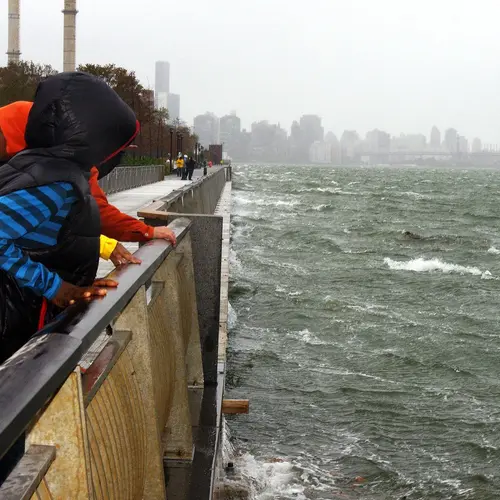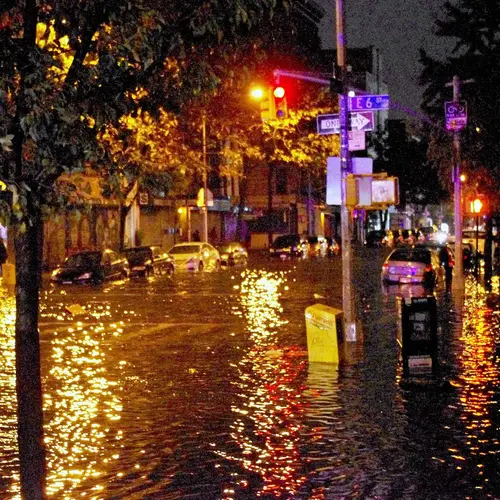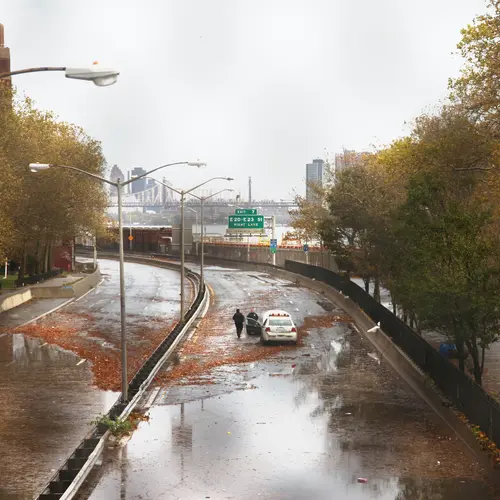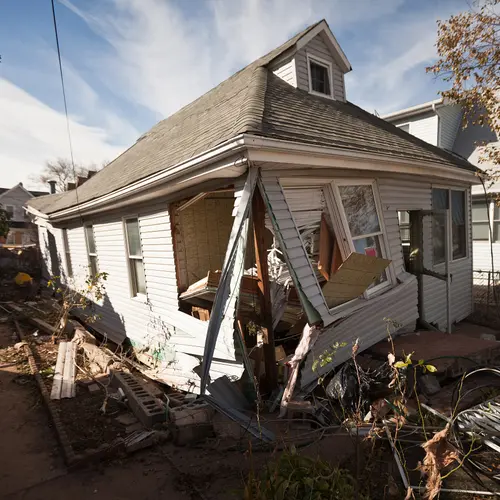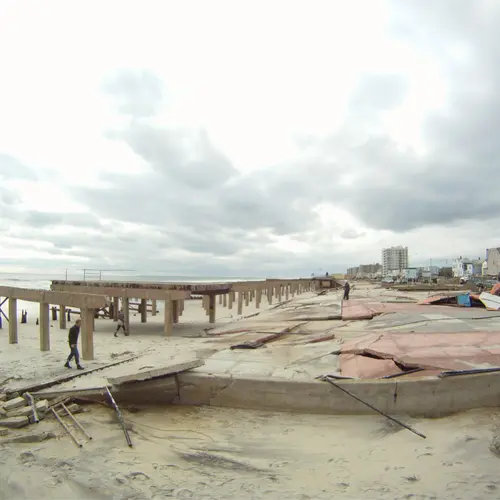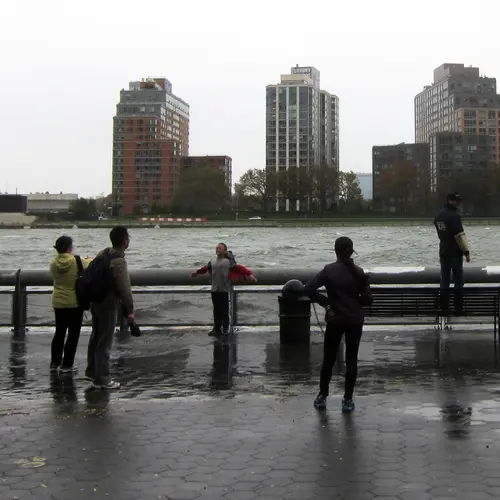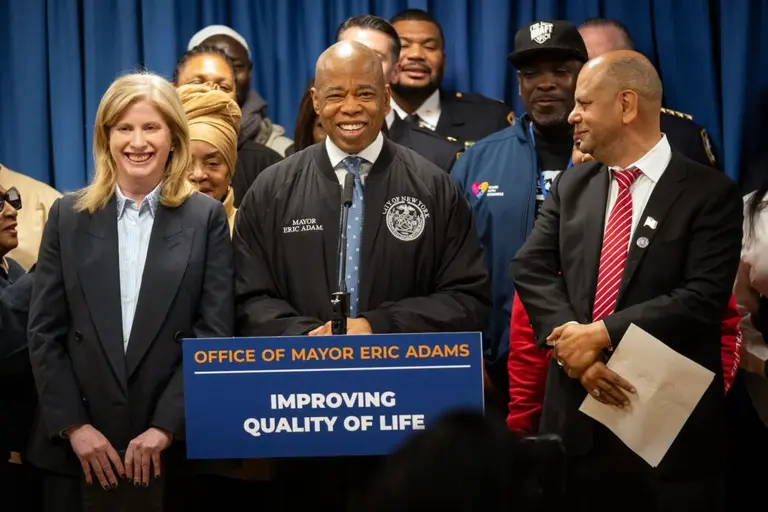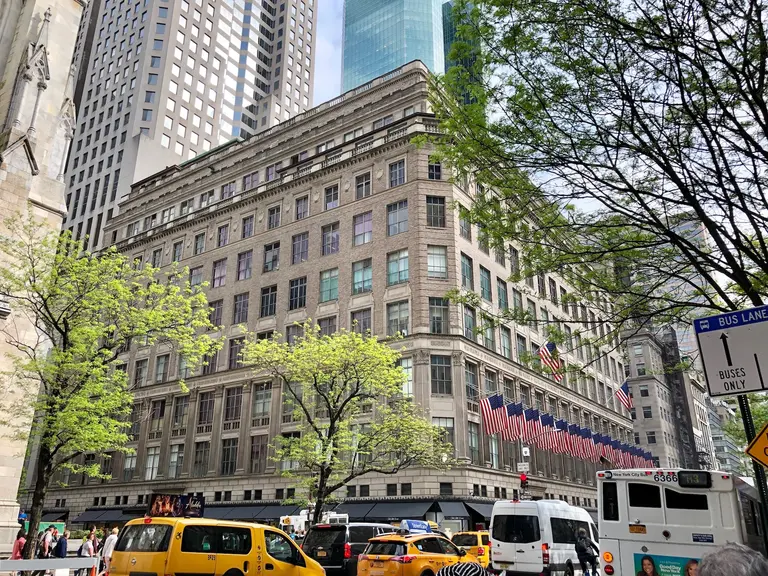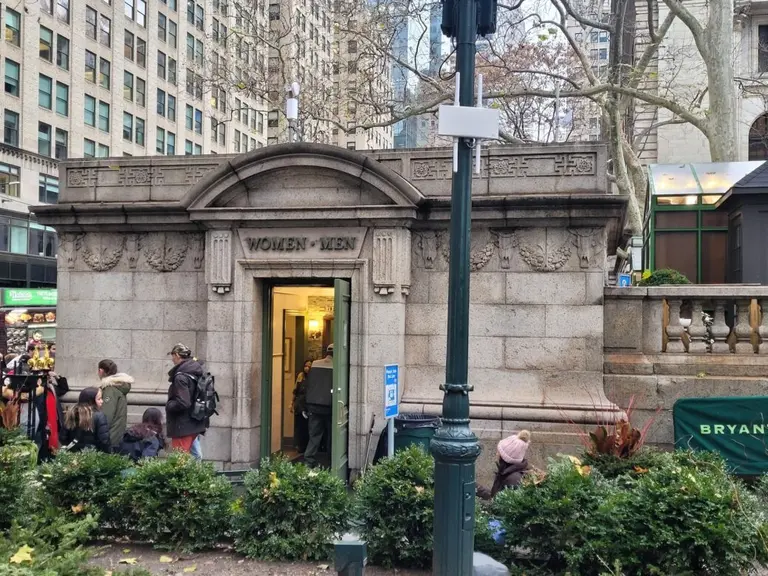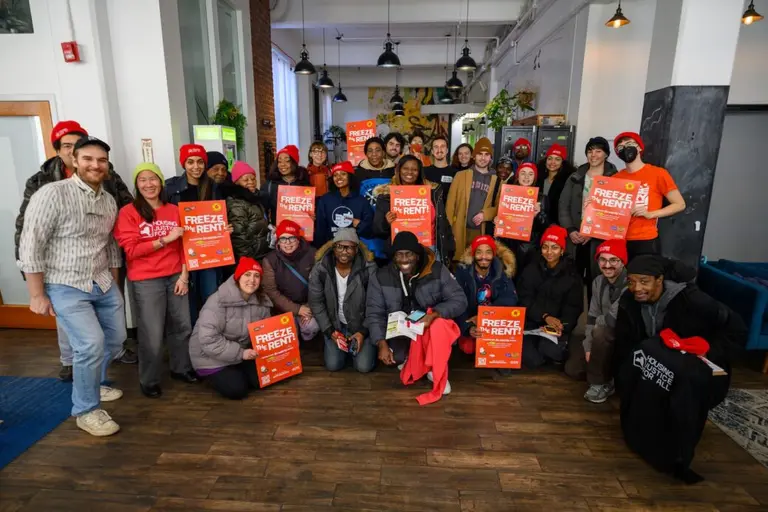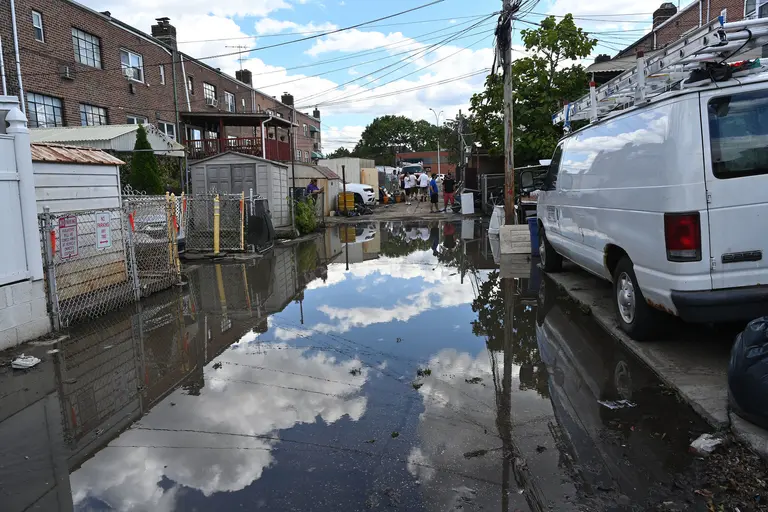10 years after Superstorm Sandy: rebuilding, redesigning and rethinking New York City
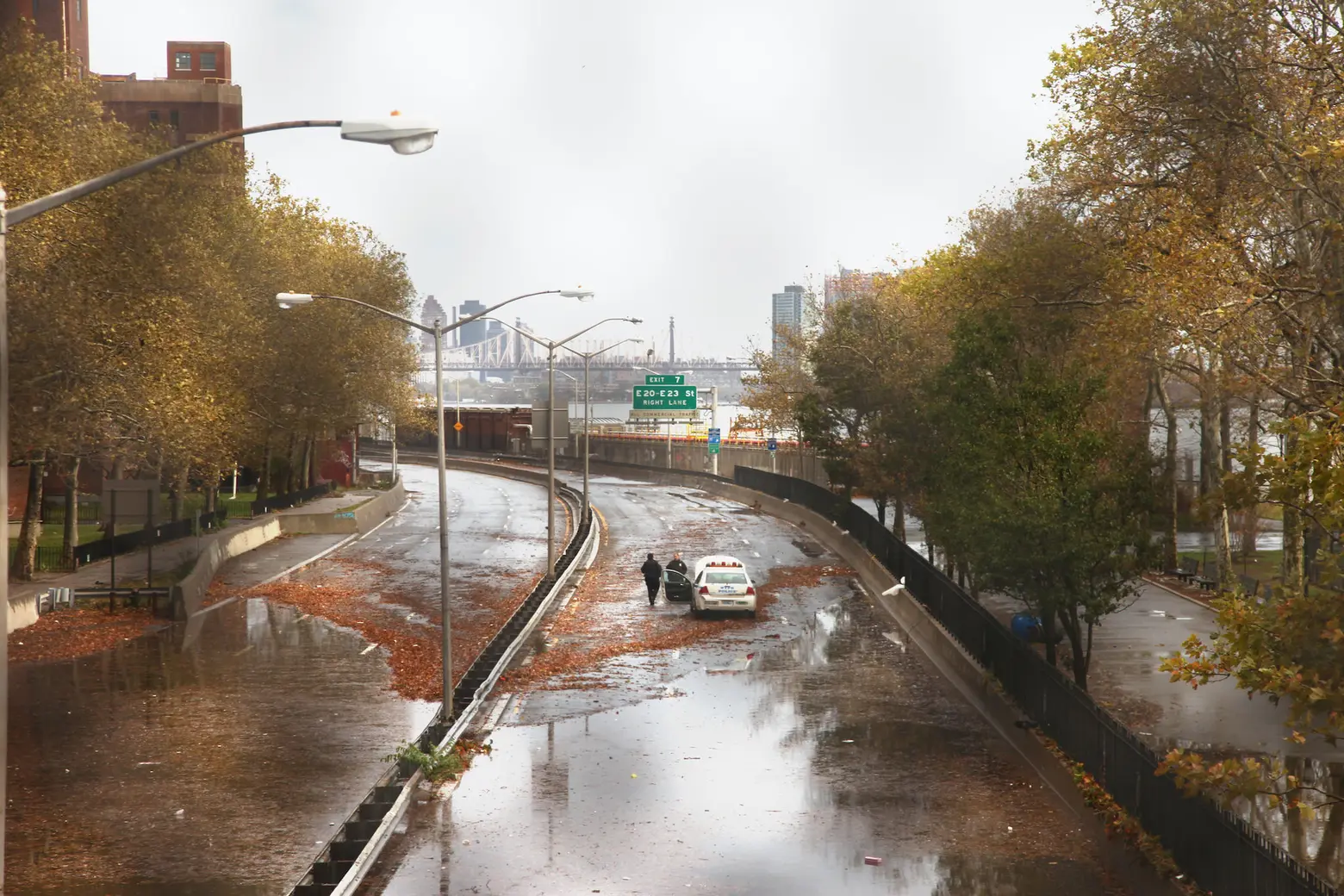
Photo credit: Chris Ford via Flickr
A decade ago, an Atlantic hurricane-turned-superstorm named Sandy caught ready-for-anything New York City completely off guard as it raged up the East Coast from the Caribbean to Canada. On October 29, 2012, the city was blindsided by an unanticipated storm surge that flooded streets and subway tunnels and cut power. It took some areas weeks to get the lights back on and, in the best of cases, open for business, and years to rebuild (an effort which is still ongoing). It goes without saying that the city would like this disaster to be the first and last of its kind, but predictions of future environmental impacts are front-page news daily. To that end, experts and innovators in architecture and engineering, government organizations, regulators, and planners have dedicated their efforts–and billions of dollars–to protect the city in a post-Sandy world. But what has really been accomplished–and is the city safer?
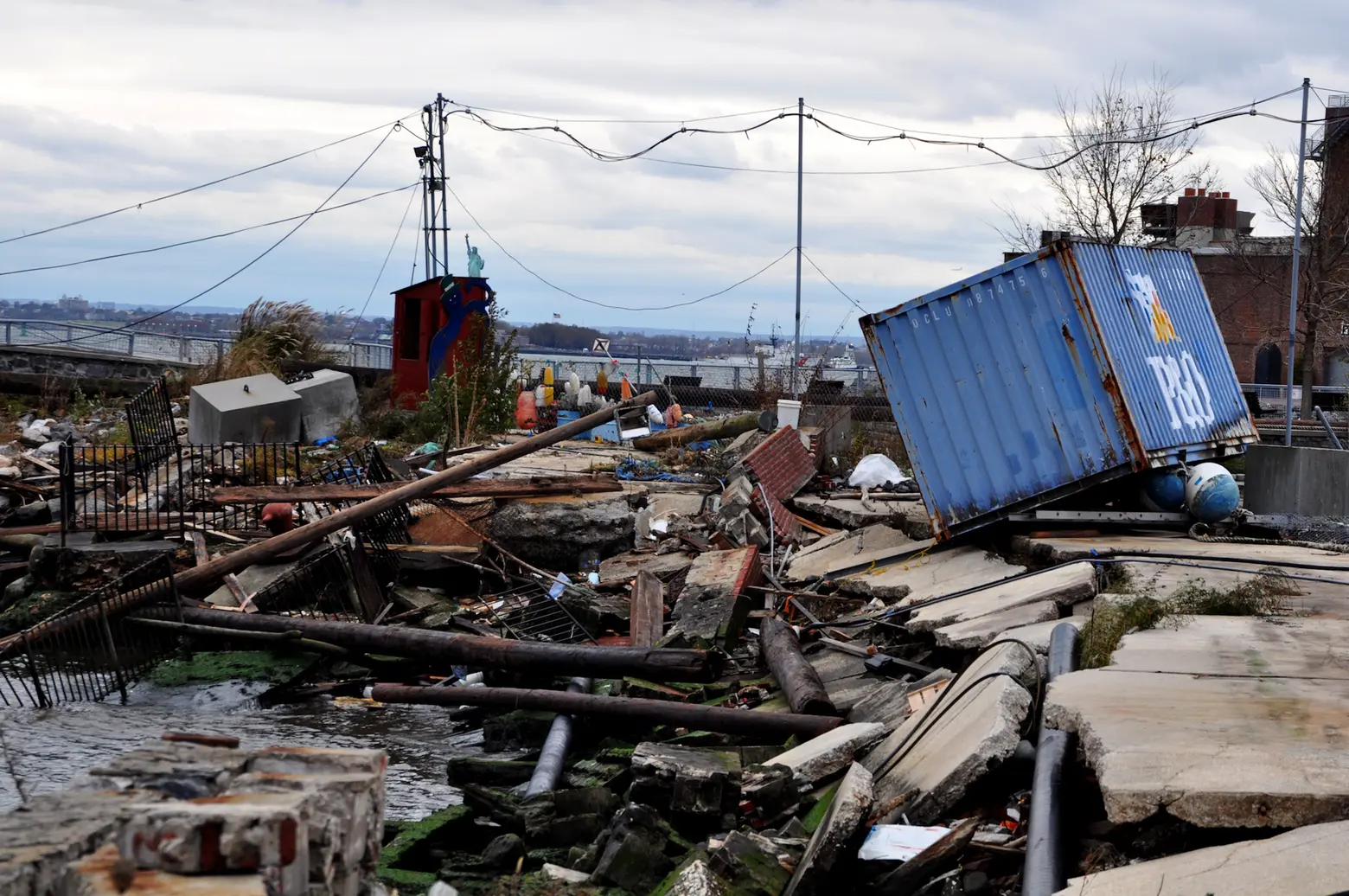 Red Hook after Sandy; Photo by Michael Fleshman on Flickr
Red Hook after Sandy; Photo by Michael Fleshman on Flickr
Hurricane Sandy was the largest recorded Atlantic hurricane by diameter, with tropical storm-force winds causing almost $70 billion in damage in its path. What followed was a monumental wave of plans to rebuild what was lost and protect the city, its coastlines, and its communities against future environmental challenges.
Reports have predicted rising sea levels and growing flood risk. By 2030, according to projections, the city could be getting windblown and waterlogged every five years. Resiliency quickly became a top imperative for rebuilding the city’s public spaces as well as protecting its fragile coastal areas.
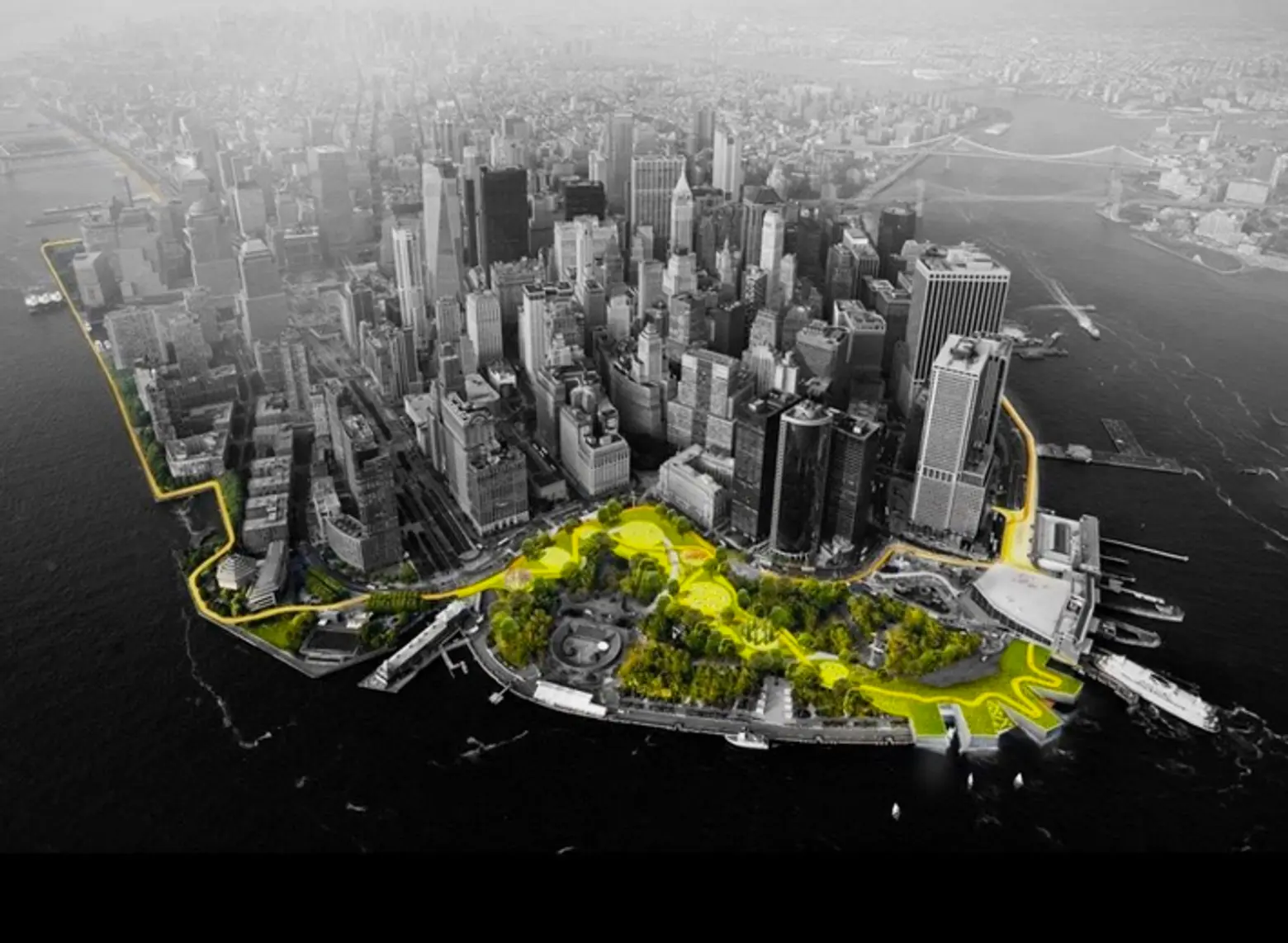 Rendering courtesy of BIG/the Mayor’s Office of Recovery & Resiliency
Rendering courtesy of BIG/the Mayor’s Office of Recovery & Resiliency
Resiliency projects: a flood of plans and funding
One of the first high-profile initiatives to create a resilient and sustainable New York City was Rebuild by Design, launched by the U.S. Department of Housing and Urban Development in the fall of 2012 with an international competition. Six winners were chosen to receive funding from then-President Barack Obama’s $4 billion disaster-recovery fund to develop their ideas. Of the original winning projects focused on NYC’s recovery and resiliency efforts, architecture firm BIG’s storm protection system has made the biggest splash. Originally known as The BIG U, BIG’s contribution became a flood-mitigation solution for Manhattan that extends from West 57th Street to East 42nd Street and all the way down to the Battery. BIG received over a third of the $920 million dispersed among the six winning bids.
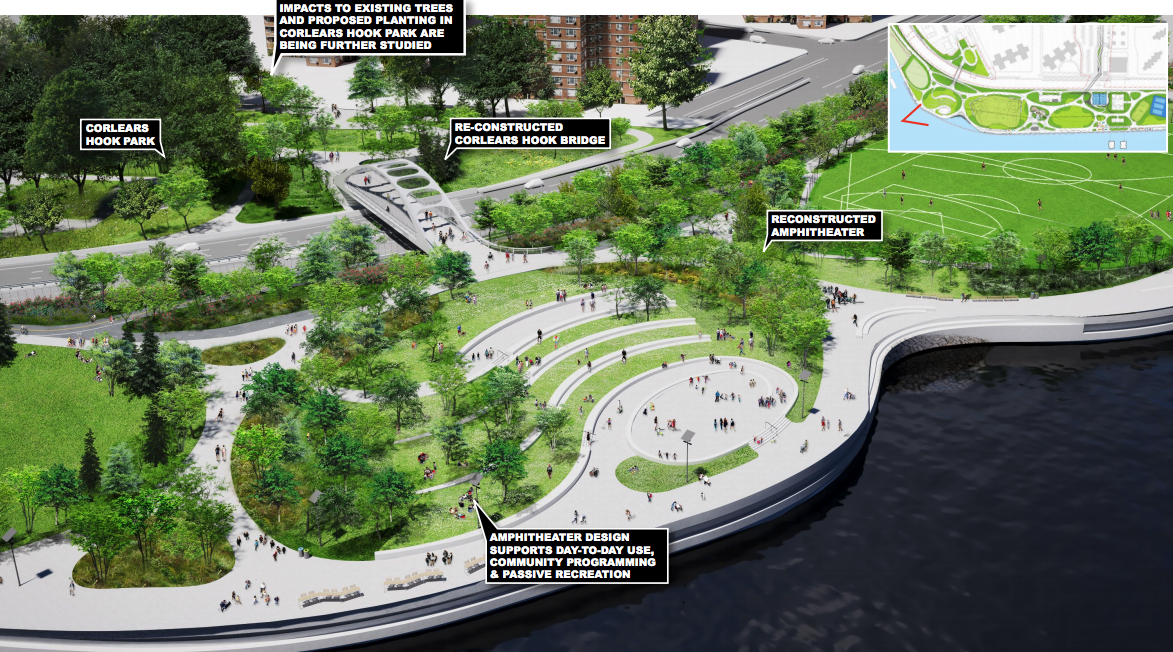 The ESCR, finally moving forward. Rendering courtesy of the Department of Design and Construction
The ESCR, finally moving forward. Rendering courtesy of the Department of Design and Construction
The plan morphed as it met with the realities of implementation, but key elements of it are among the most comprehensive landscape design-based actions being taken to protect the city, with a $2.709 billion total budget attached. The East Side Coastal Resiliency Project (ESCR), finally moving forward after nearly a decade of planning and community discussion, involves the reconstruction of the 64-acre, 1.5-mile East River Park, a flood protection system conceived in the wake of Hurricane Sandy. ESCR is the first of three phases of the original BIG U plan.
Construction on the ESCR project began in 2020 and will continue through 2026. As part of the project, Mayor Eric Adams cut the ribbon on the new Asser Levy Playground this year; the playground was rebuilt with resilient materials including a 320-foot floodwall and a 79-foot sliding floodgate. Restoration of the northern part of Stuyvesant Cove Park will be completed this year as well.
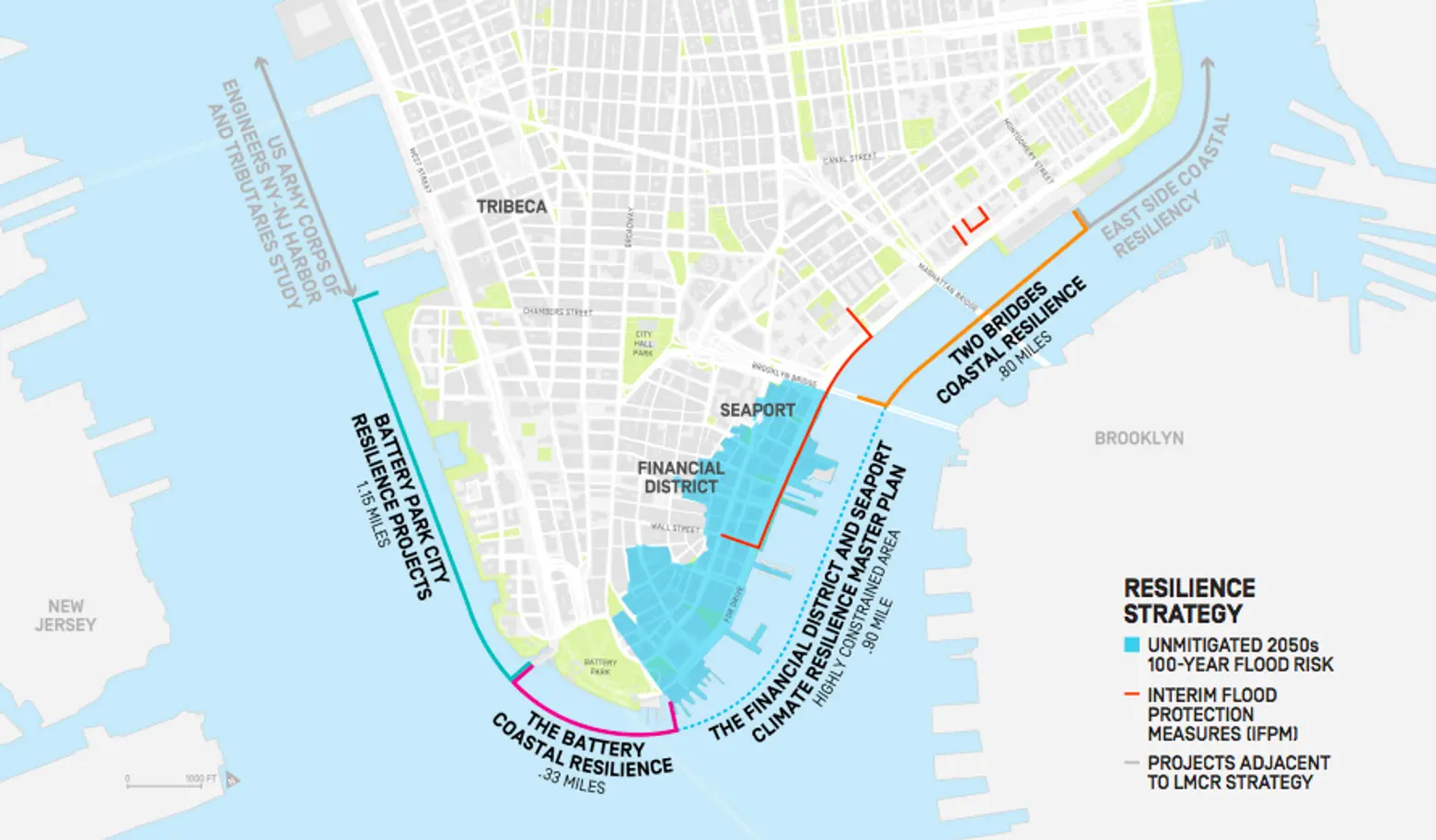 Photo credit: Mayor Bill de Blasio’s office
Photo credit: Mayor Bill de Blasio’s office
In 2019, Mayor Bill de Blasio unveiled a second part of the same initiative: a $10 billion plan to extend the coastline of lower Manhattan as much as 500 feet to protect it from future floods. The Lower Manhattan Coastal Resiliency Project (LMCR) includes Manhattan’s Financial District and South Street Seaport, following a study that found the only feasible measure for these areas would be extending the shoreline about two city blocks into the East River by adding a new piece of land at or above 20 feet from current sea level.
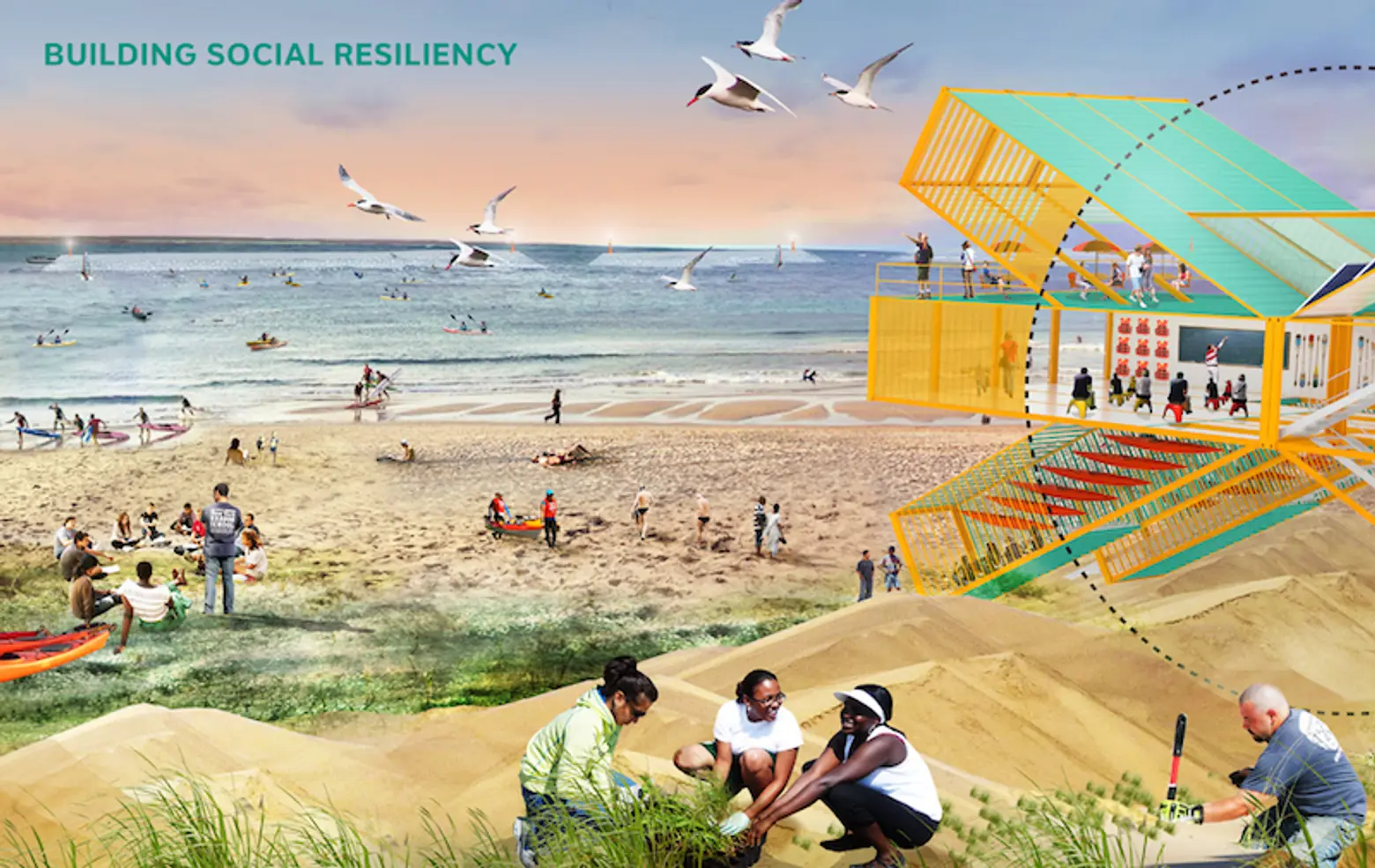 Image courtesy of SCAPE / LANDSCAPE ARCHITECTURE PLLC
Image courtesy of SCAPE / LANDSCAPE ARCHITECTURE PLLC
On Staten Island, one of the areas hardest hit by Sandy’s wrath, Living Breakwaters, a winning Rebuild by Design plan submitted by SCAPE/Landscape Architecture seeks to create a water-based culture and educate future generations while rebuilding the local ecology with rocky, sloped walls that will weaken destructive waves.
With a budget of $107 million, the plan’s construction team is on track to complete the first two breakwaters this year, with construction slated for completion by fall 2024. An additional Tottenville coastline restoration was begun in 2021.
Additional winning Rebuild by Design submissions now in various stages of implementation include Living with the Bay; New Meadowlands, which focuses on creating more protective marshlands at the edge of New Jersey; Resist, Delay, Store, Discharge, architectural firm OMA’s plan for protecting Hoboken’s coastline; and Hunts Point Lifelines, PennDesign/OLIN’s design to protect the Bronx’s Hunts Point with waterfront greenway.
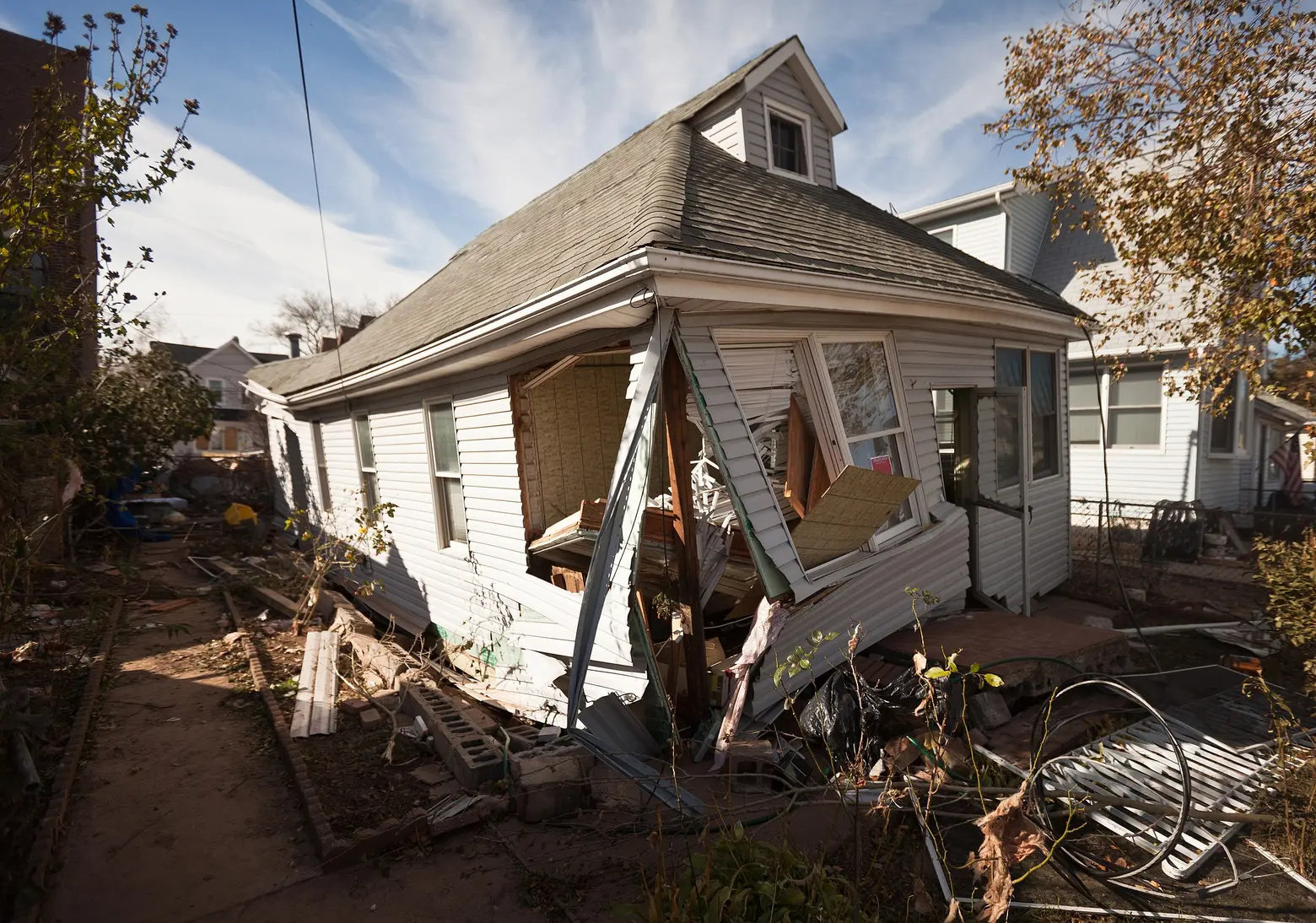 One of many houses in Staten Island, N.Y. destroyed by Hurricane Sandy, Nov. 6. Sandy ravaged portions of the Northeastern United States in October 2012. Photo via Wikimedia cc.
One of many houses in Staten Island, N.Y. destroyed by Hurricane Sandy, Nov. 6. Sandy ravaged portions of the Northeastern United States in October 2012. Photo via Wikimedia cc.
Rebuild by Design may have led the charge, but a veritable floodgate was open, ushering in a tsunami of rebuilding and resiliency projects with generous funding attached. The city’s Build it Back program began in 2013 to help people whose homes were destroyed by the storm rebuild and repair their homes and lives.
In 2014, it was announced that the state of New York would receive $35,800,000 in National Disaster Resilience Competition (NDRC) funding to support public housing resiliency pilots throughout the state and help to repair damage from recent disasters like Superstorm Sandy and Hurricane Irene and pilot new approaches to build resilience in low-income multifamily properties. Under the same program, New York City would receive $176,000,000 in NDRC funding for the aforementioned Lower Manhattan Project.
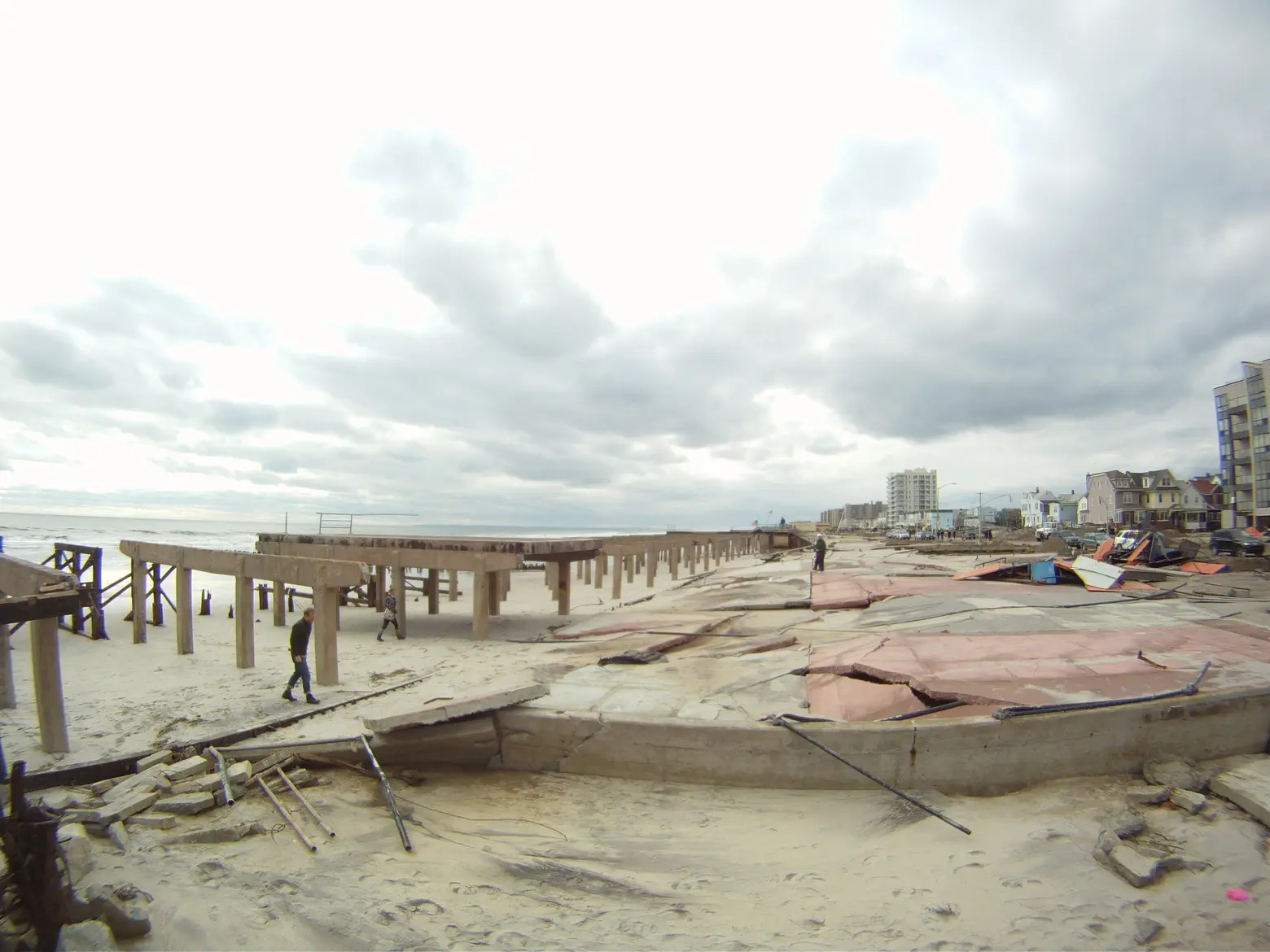
The Rockaways, post-Sandy. Photo via Wikimedia cc.
In 2017, the de Blasio administration announced a $145 million investment to help protect the Rockaways from future storms. In 2019, the Coastal Storm Plan put more effort toward safeguarding the city’s shores. The Resilient Neighborhoods Initiative, now in its public review stage, finds neighborhood-specific strategies–including zoning and land use changes–to support and protect communities in the floodplain. In 2021, the Mayor’s Office of Climate Resiliency (MOCR), released a comprehensive Coastal Protection Plan that made further mention of communities and neighborhoods as well as infrastructure and environment.
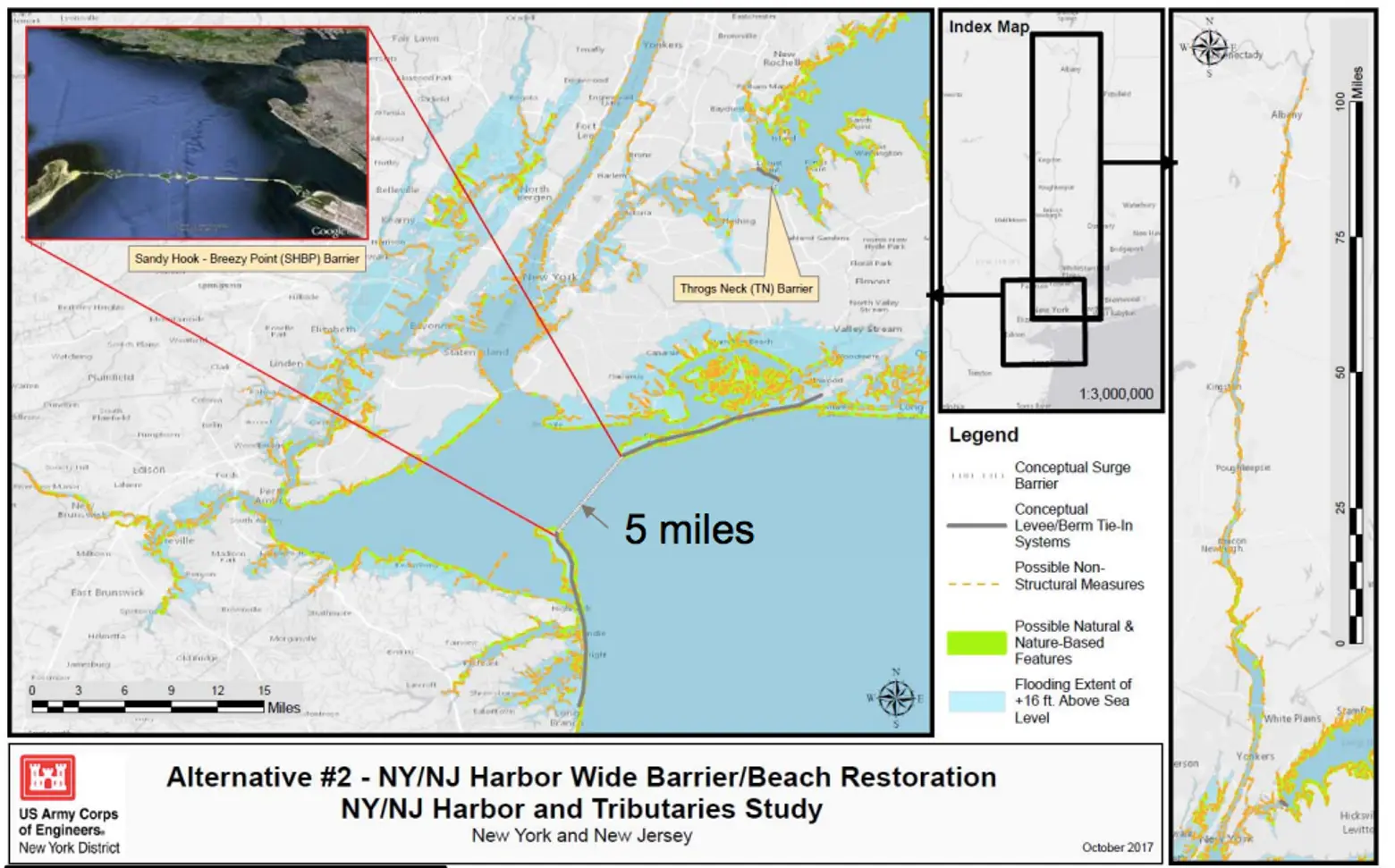 Image via US Army Corps
Image via US Army Corps
In September of this year, the U.S. Army Corps of Engineers released a report updating their proposed $52 billion plan, first released in 2018, to protect the New York City metropolitan area from storm surges and coastal flooding, marking significant progress in a long-delayed study that began in the aftermath of Hurricane Sandy.
In the upcoming 2022 election, the Environmental Bond Act will appear on New York state ballots. The referendum will decide whether to allow the state to borrow up to $4.2 billion for projects that address climate change, land conservation, and flood prevention measures; within that $250 million would be set aside for the controversial idea of managed retreat.
Mayor Adams has inherited a hefty legacy of requirements tied to resiliency plans and guidelines, including one that followed in the path of Hurricane Ida. Two more plans will be released this year, including one from the city’s climate resiliency office and another plan for all five boroughs required by a recently-passed law.
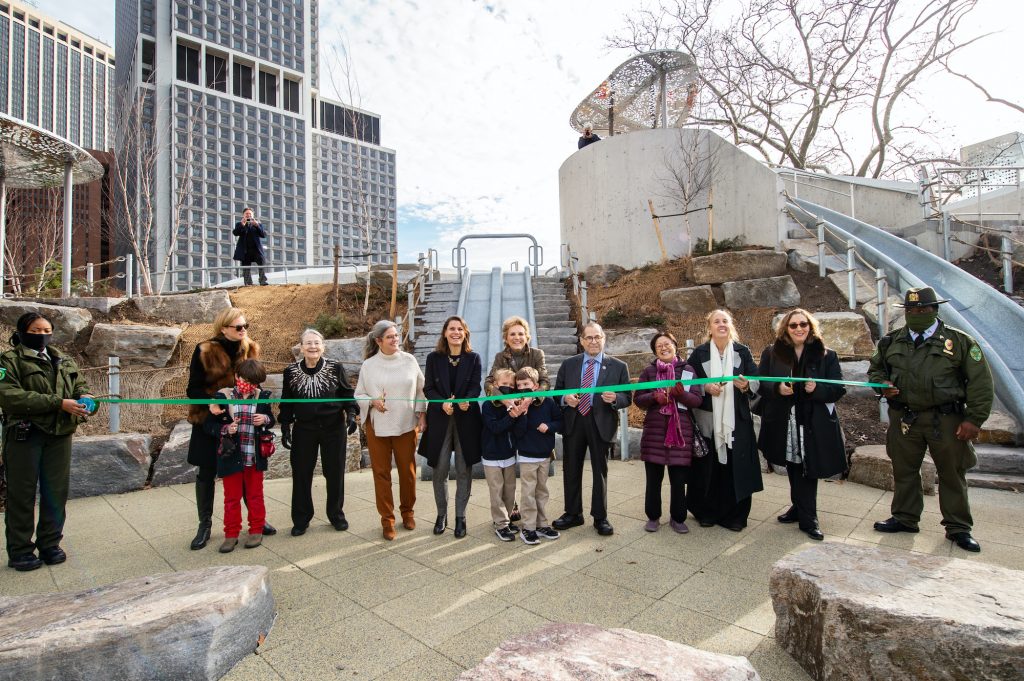 Battery Playscape, one of New York City’s largest sustainable parks, is now open. Photo courtesy of Diane Bondareff/AP Images for The Battery Conservancy.
Battery Playscape, one of New York City’s largest sustainable parks, is now open. Photo courtesy of Diane Bondareff/AP Images for The Battery Conservancy.
Silver linings: innovations in architecture and design
The Rebuild by Design competition and subsequent projects underscored the importance of advances in the built environment. This consideration–a silver lining perhaps–has led to unprecedented innovation in architecture and design.
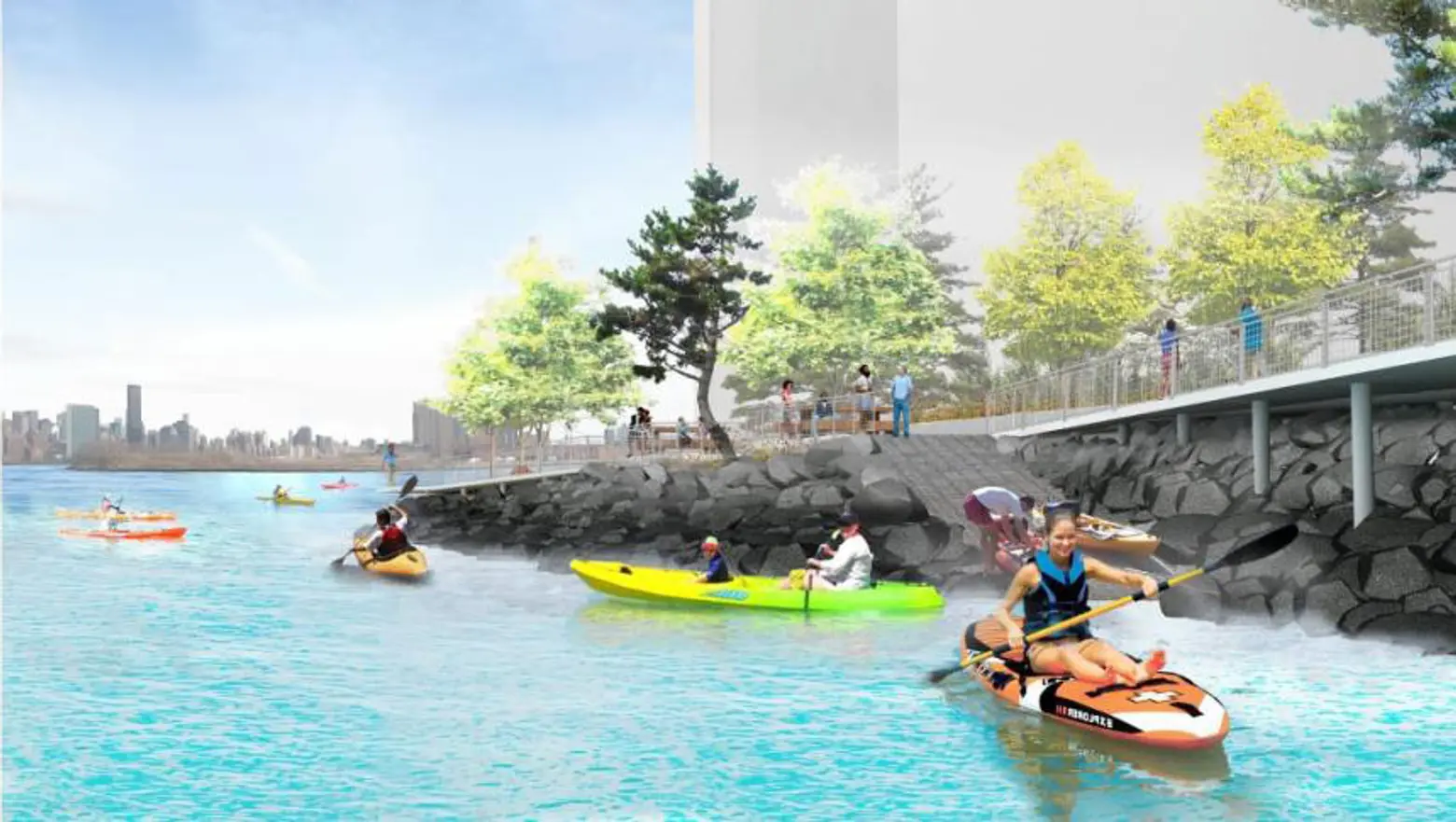
Image courtesy of James Corner Field Operations
Developers in NYC are incorporating resilient design into projects by necessity. North Brooklyn megaproject Greenpoint Landing features a waterfront park adjacent to the massive residential development. The park’s designer, James Corner Field Operations, constructed sloping, split-level terraces and salt-tolerant greenery that will absorb water. The split-level terracing will also elevate the ridge well above FEMA regulations.
1 Hotel Brooklyn Bridge Park, designed by Marvel Architects, was sitting at sea level when Sandy hit, and required a redesign to withstand future storms. The entire building was lifted five feet.
In doing that, principal Jonathan Marvel recounts to Dezeen, “…we really created an elevated plaza that didn’t exist in the previous design. We created new ramps and stairs, and we had to pick up all of the boilers and create these bulkheads on the roof, because what normally would have been underground now had to be raised above ground.” The firm also installed floodgates at the ground-level garage doors.
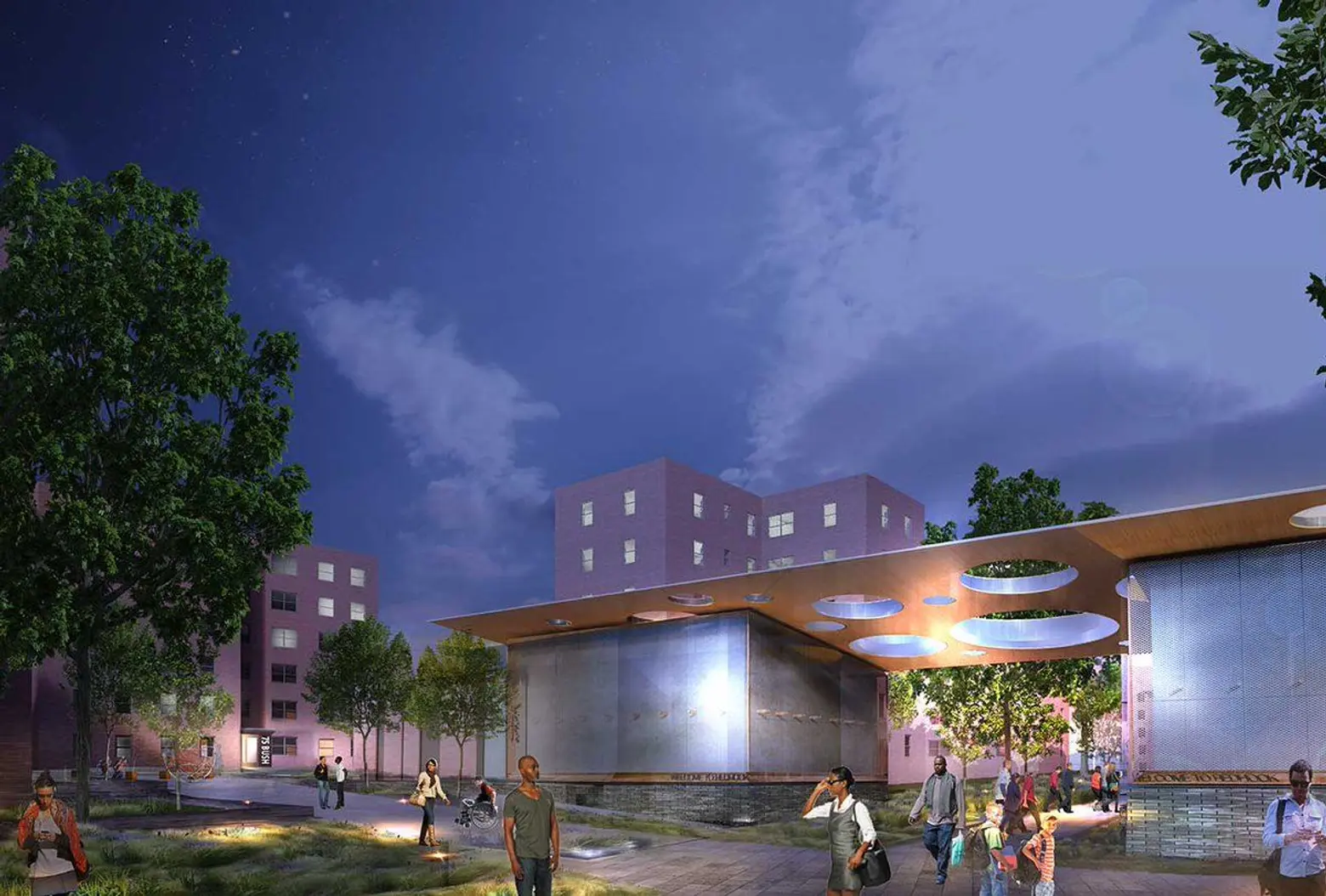 Photo via KPF
Photo via KPF
Despite the buzz created by these big-budget projects, many argue that a focus on neighborhoods and local communities is equally–if not more– important to set design precedents as well as to protect residents where they live. As 6sqft previously reported, architecture firm KPF in collaboration with NYCHA, created a resiliency and renewal program for the Red Hook Houses in Brooklyn, which were hit hard by Hurricane Sandy. The redevelopment plans aim to reduce the vulnerability of the area and its community with projects that include a freestanding building for above-ground boilers that incorporates amenities into its design.
As the front line for sea level rise and flooding threats, the city’s beaches face a unique challenge. One part of the effort to bring the public beaches into the 21st century and beyond involved replacing tattered service buildings with new, pre-fabricated, solar-powered modular pods, designed by Garrison Architects, that held offices, bathrooms, and lifeguard stations. The modern, FEMA-approved structures sit on stilts that raise them above storm-surge levels.
In the Rockaways, colorful concrete “islands,” designed by Sage & Coombe Architects, have been built at various spots along the boardwalk to offer seating areas and restrooms. WXY architecture + design’s “Rockaway Dune Walk,” along with local and federal agencies, constructed an elevated 5.5-mile concrete boardwalk from Beach 9th Street to Beach 126th Street. The project also added six miles of seawall and other protective additions to mitigate tidal forces.
Where real estate development meets the beach, Salt Meadow, a 60-unit townhouse complex by JDS Development Group gave architecture firm CetraRuddy an opportunity to tackle the concept of designing homes in a flood zone that was deeply affected by Sandy’s impact. In creating the development’s two-family townhouses, the firm designed living spaces and electrical closets above the base flood elevation and ground floors to hold storage, garage, and unfinished areas. The homes have permanent flood vents to allow water to pass in or out of exterior foundation walls.
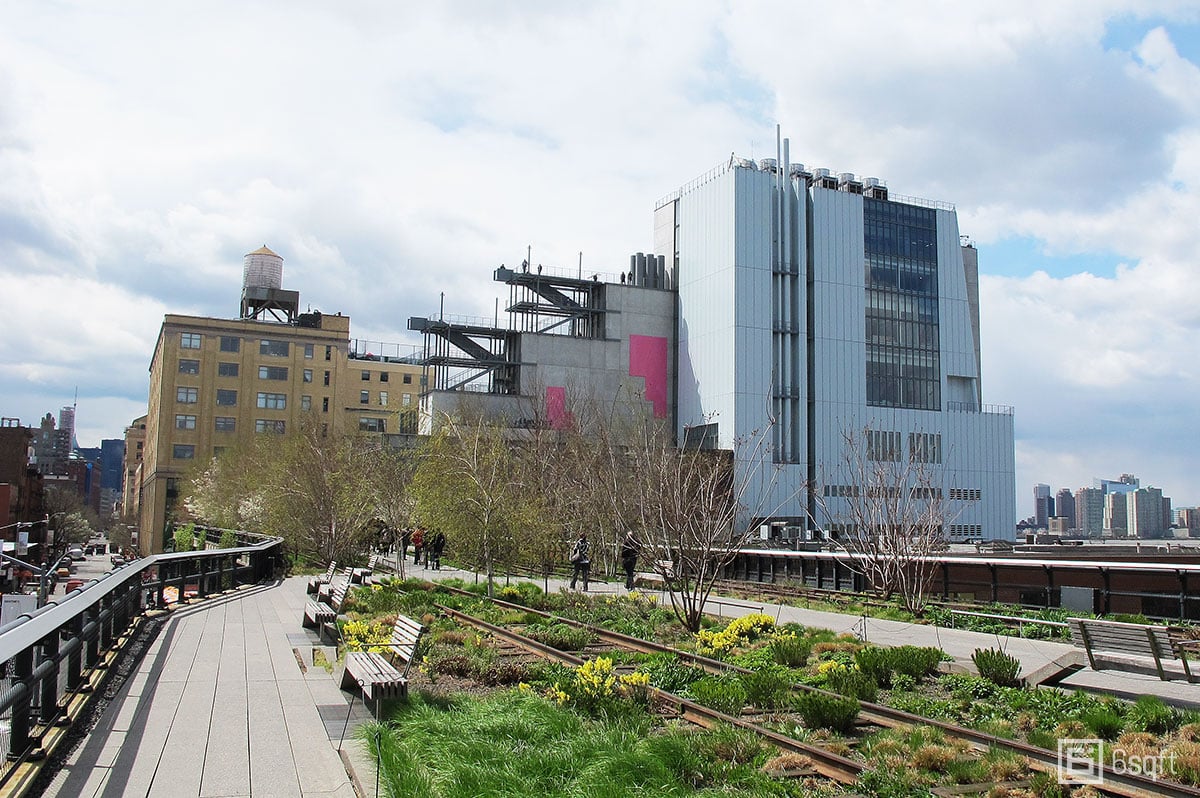 The new Whitney Museum. Photo ©6sqft
The new Whitney Museum. Photo ©6sqft
Protecting culture and community also involves protecting the city’s valuable art collections. Renzo Piano’s now-famous design for the relocated Whitney Museum of American Art did an about-face after Sandy to consider the potential effects of flooding. Designed in Sandy’s aftermath, when the building was already halfway complete–and flooded with millions of gallons of water–the museum’s flood mitigation system includes a 15,500-pound door designed by engineers who build water-tight latches for the U.S. Navy’s Destroyers. According to Kevin Schorn, an engineer and assistant to Piano: “Buildings now have to be designed like submarines.”
The Whitney is now protected against a flood level of 16.5 feet—seven feet higher than the water reached during Sandy. A 500-foot-long mobile wall made of stacked aluminum beams stands at the ready; it can be called into action in seven hours. The building’s massive Hudson-facing flood door is also balanced so that one person can shut it quickly. Both of these structures have been designed to withstand thousands of pounds of impact from storm debris.
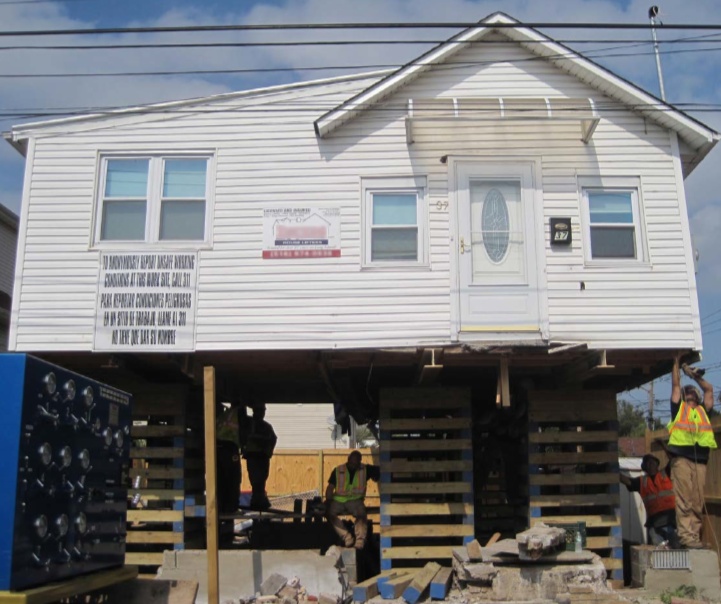
A house being raised in Midland Beach on Staten Island. Photo via NYC Department of City Planning
Shoring up codes, regulations, and standards
In addition to creating new models for the city’s buildings and coastlines, regulations were created to assure that protections stayed in place even after the city emerged from disaster recovery mode. The Federal Emergency Management Agency (FEMA) flood zones outlined for the city were revamped shortly after the hurricane.
This change illuminated some uncomfortable facts about existing conditions. A study of the flood zones found that $129 billion worth of New York City real estate fell within the new FEMA flood zones. Complying with the current FEMA regulations could cost the city $5 billion.
In 2013, the New York senate passed comprehensive legislation that took the lessons learned after Sandy to heart. New building codes were created, and more controversial items, such as zoning changes, accompanied the resilience retrofits and beefed-up building codes.
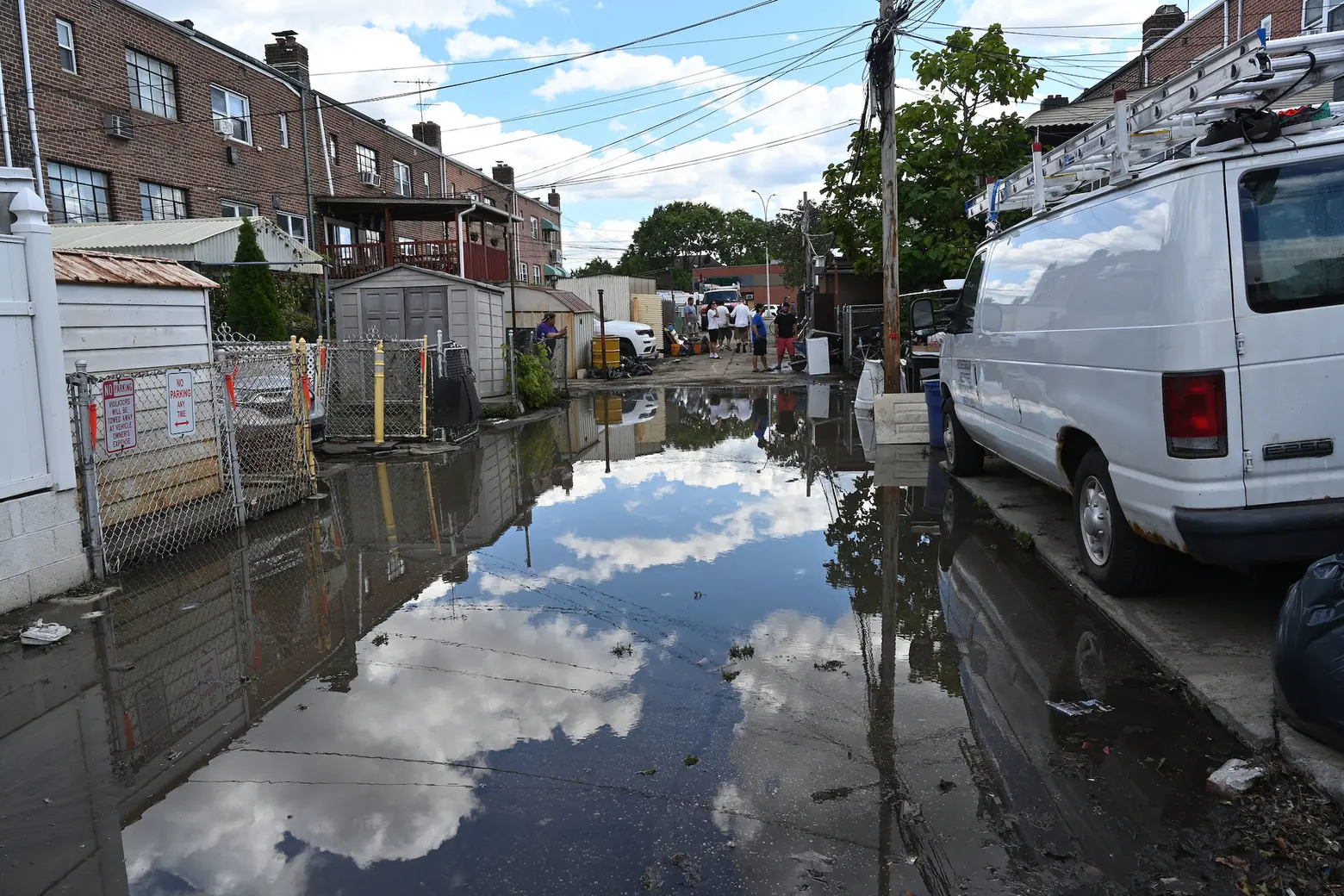 September 3, 2021: Gov. Kathy Hochul toured several homes in East Elmhurst, Queens that flooded from torrential rains brought on by Hurricane Ida. Photo by Kevin P. Coughlin / Office of the Governor on Flickr
September 3, 2021: Gov. Kathy Hochul toured several homes in East Elmhurst, Queens that flooded from torrential rains brought on by Hurricane Ida. Photo by Kevin P. Coughlin / Office of the Governor on Flickr
Where are we now–and is the city safer?
As we reach the 10-year mark, how far have we come in building a New York City whose residents and communities are safe from the ravages of future storms and other environmental challenges? There is no doubt that progress has been made, the best of which may be the now-permanent place resiliency occupies in any conversation involving infrastructure.
But the challenges that come with implementing multi-billion-dollar projects in the city’s populous and diverse communities are unprecedented. The recent damage wrought by Hurricane Ida illuminated once again both the need for economic and community consideration in building a resilient city and the difficulty in factoring in the unexpected.
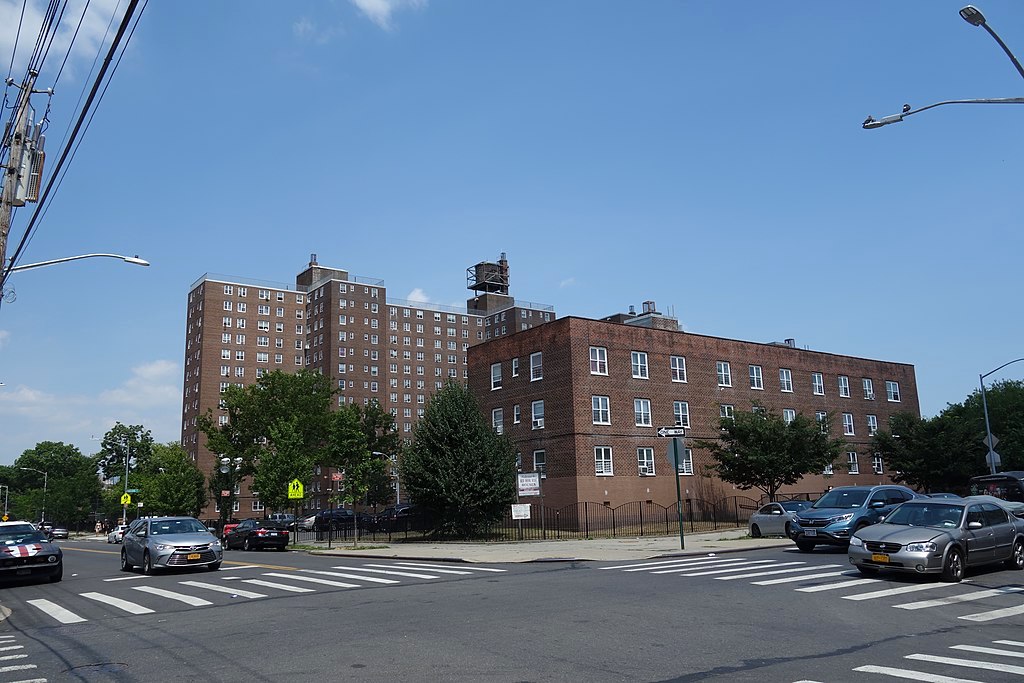
The Red Hook Houses; Photo by Tdorante10 on Wikimedia
According to a NY1 report, as of 2019, the city’s public housing is woefully behind in much-needed repairs and updates to its buildings, which NYCHA has estimated at $40 billion. Even with $3.2 billion in funding–the largest single federal investment in the history of public housing–stormwater flooding is still a problem across NYCHA buildings.
Checking in on the Build it Back initiative, reports show that progress has been uneven at best (then-NYC Comptroller Scott Stringer called it “a case study in dysfunction”). And as of 2019, the city had reportedly repaired only two of 35 NYCHA developments damaged by Sandy.
A recent Bloomberg report suggests that New York City is still vulnerable to hurricanes, based on new data released by the NYC comptroller. Another recent report shows that, of the nearly $15 billion of federal grants, 27 percent remain unspent, and many coastal resiliency projects remain years from completion.
The next few years will be crucial ones for the city as it competes for billions of dollars unlocked by the $1 trillion federal infrastructure bill passed in November 2021. Adaptation experts point to the need to bring as many fully-realized plans as possible to the table.
During a public conversation held recently at the New York Historical Society to mark the 10th anniversary of Hurricane Sandy, design leaders discussed their work with Rebuild By Design–and took an honest look at how much success has been achieved. One recurring conclusion: In order to make progress at any level, the overall mindset must change. Beyond New York City, America’s systems, structures, and thinking–starting with education–must shift in order to include ways of building and living that can adapt to environmental change.
Matthijs Bouw of ONE Architecture, who worked on the BIG U design for lower Manhattan, explained that “the fundamental solution in Manhattan, because of its density, is barriers. We cannot change the city overnight and let the water in,” but as part of the long view, he sees progress as a process of rethinking.
“Suddenly we see that this hubris with which we built our cities is not working.” Bouw sees the multi-generational projects of the future as “undoing many of the mistakes that we have made in the way we have constructed our cities in the centuries before us.”
Kate Orff, founding principal of SCAPE, whose Living Breakwaters project is being implemented in Staten Island, addresses the limits of nature-based solutions like Breakwaters: “They reduce risk to people on the shoreline–but risk remains. So I feel like there’s a huge black hole relative to pulling together legal, financial, managed retreat and other forms of flexibility, and pooling those solutions so they are paired with nature-based solutions.”
Bouw believes community involvement makes projects better, if more difficult, but the conversation must go beyond the project-specific: “Because these processes are so complicated, and we are dealing with projects that will continue–these are successional projects, we will be working on these coastlines for the next decades if not centuries.”
He added: “What I really dislike is that all the communication is focused around the one project, and not around the fact that we need to have a comprehensive conversation in which we build stewardship, in which we build understanding, in which we learn to speak in a language. Because if we learn to do that, we’ll be able to make much better plans together.”
RELATED:
- City has repaired just two of 35 NYCHA developments damaged by Hurricane Sandy
- De Blasio unveils $10B plan to flood-proof Lower Manhattan by extending shoreline into the East River
- Army Corps proposes constructing hurricane barriers across the NY Harbor to stop flooding
- The Urban Lens: Remembering the darkness of Hurricane Sandy five years later
